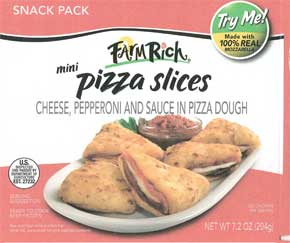 Three federal agencies traced a 2013 outbreak of E. coli O121 to Farm Rich brand frozen snacks, including mini pizza slices, mozzarella bites, mini quesadillas and philly cheese steaks. A broad recall of those products was launched, including Schwan’s and Market Day brand frozen snacks produced at the same Farm Rich plant in Waycross, Georgia. Across 19 states, a total of 35 people were confirmed as case patients in this outbreak, including two who suffered kidney failure and other harms from a toxic E. coli complication known as hemolytic uremic syndrome.
Three federal agencies traced a 2013 outbreak of E. coli O121 to Farm Rich brand frozen snacks, including mini pizza slices, mozzarella bites, mini quesadillas and philly cheese steaks. A broad recall of those products was launched, including Schwan’s and Market Day brand frozen snacks produced at the same Farm Rich plant in Waycross, Georgia. Across 19 states, a total of 35 people were confirmed as case patients in this outbreak, including two who suffered kidney failure and other harms from a toxic E. coli complication known as hemolytic uremic syndrome.
Ohio, Texas, Michigan and New York were among the hardest hit states in the Farm Rich E. coli outbreak, which lasted six months as consumers went to their freezers while unaware of the contamination. Farm Rich E. coli lawsuit evidence clinched in this case includes the outbreak strain of E. coli O121 identified in two different Farm Rich brand frozen products collected from the homes of two ill persons in New York and Texas. Even if your illness was not life threatening, you could still receive substantial compensation from the parties responsible for this outbreak.
When the outbreak was declared over at the end of May 2013, public health officials voiced concerns that some consumers would remain unaware of the broad recall of snacks produced by Farm Rich — a recall that encompassed 196,222 pounds of frozen food. “Many of these products have a long shelf-life, and they may still be in peoples’ freezers,” the U.S. Food and Drug Administration said in a Sept. 12, 2013, update. “Consumers unaware of the recall could continue to eat these products and potentially get sick.”
Scientific, regulatory and investigative response to this outbreak came from plaintiffs’ lawyers like PritzkerOlsen Attorneys, the USDA’s Food Safety Inspection Service, the FDA, Centers for Disease Control and Prevention and multiple public health agencies at the state level. The traceback effort was successful in linking Farm Rich and its Waycross plant to the outbreak, but there were no additional findings as to what ingredients or cross-contamination may have been at the root of the toxic E. coli food poisoning.




